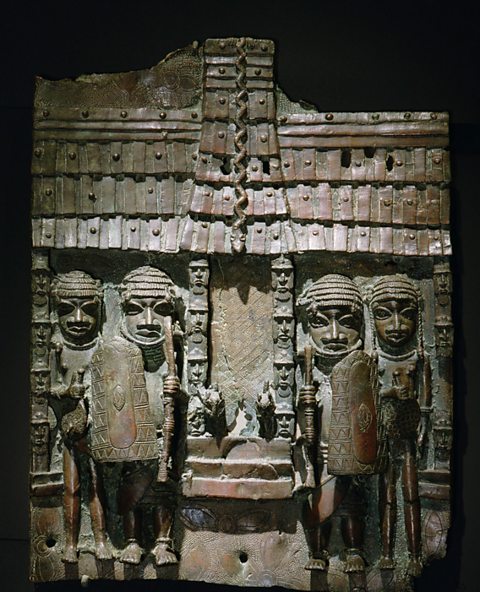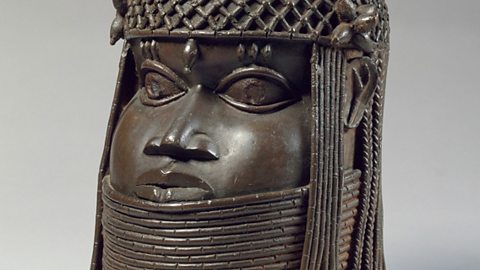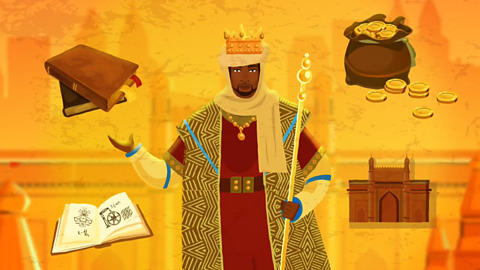Key points
- The Kingdom of Benin was located in what is now known as southern Nigeria.
- The kingdom was led by the Oba, a powerful leader who was believed to be descended from the gods.
- The Obas used art and architecture to show their power. Benin became famous for its bronzes, intricate art cast in bronze and ivory.
This is a Benin bronze. It was cast by one of the Obaās metalworkers to decorate the pillars of his palace. What can you see in this bronze? What might it represent?

The Obas lived in a large, luxurious palace in the centre of Edo City. The palace contained a series of courtyards and a large, open air central hall in which the Oba met with important guests.
The palace halls had pillars that would be decorated with bronze plaques, such as this one. The pillars are represented in the middle of the bronze between the two central figures. Above the figures is the roof of the palace, with a snake on it. Pythons were used in the art of Benin to show the power of the Oba. It was said that pythons had been sent by the God Olokun to punish wrongdoers. The python therefore tells the viewer that the Oba too has the power to punish.
The origins of Benin
From around 500, the Edo people lived in villages and were ruled by a leader known as Ogiso. Ogiso means āking of the skyā. The Ogisos called their land Igodomigodo.
By 1100, there were struggles for power and the Ogisos lost control of their kingdom. The Edo people feared that their country would fall into chaos, so they asked their neighbour, the king of , for help. The king sent his son Prince Oranmiyan to restore peace to Igodomigodo.
Prince Oranmiyan chose his son, Eweka, to be the first ObaThe leader of the kingdom of Benin. , and Igodomigodo became the Kingdom of Benin. Eweka was the first in a long line of rulers known as Obas.
Activity - Put the events in order
The Obas of Benin
Between 1440 and 1601, Benin was ruled by a successionThe order in which sons followed their father to be Oba. of āwarriorā kings who were instrumental in growing the kingdom. Under their rule the kingdom grew in wealth and they expanded their territory. Oba Ewuare, also known as āEwuare the Greatā was first of these kings. His reign had a significant impact on the kingdom.
| Oba | Key fact |
|---|---|
| Oba Ewuare I (Ewuare the Great) | He dramatically increased the size of the empire and rebuilt Benin City and the royal palaces. He was the first warrior Oba. |
| Oba Ozolua | He was Ewuareās son and is said to have won over 200 battles. |
| Oba Esigie | He expanded his kingdom eastwards, taking land from the Kingdom of Ife. |
| Oba Orhogbua | The empire reached its largest size during his reign. It stretched beyond the River Niger in the east and extended west as far as present-day Ghana. |
| Oba Ehengbuda | He was the last of the warrior kings. However, he spent most of his reign stopping rebellions led by local chiefs. After his death in 1601, Beninās empire gradually shrank in size. |
What impact did Oba Ewuare have on the kingdom of Benin?
Oba Ewuare was also known as āEwuare the Greatā. Ewuare overthrew his brother, Uwaifiokun, to become the leader of Benin. Oral history remembers him as a skilled fighter who possessed magical powers.
Oba Ewuare believed his military talent was linked to his supernatural powers and knowledge of magic and herbs. He set up a festival known as the Igue to renew his power, and a festival called Ugie Erha festival to honour his Oba ancestors.
Ewuare rebuilt the capital of the kingdom, Edo City, which is present-day Benin City. A wall was built around the capital and included moats for increased protection. The wall took decades to create, and it is estimated to have been over 6,000 miles long.
The strong defences in the capital gave the kingdom stability and meant Ewuare could lead campaigns to increase the size of his kingdom. During his rule, the size and power of the kingdom dramatically increased, and the kingdom now controlled a large area of coastline.
The expansion of the empire enabled the kingdom to start trading with the Europeans, which made the kingdom extremely prosperous. Benin traded goods, including ivory and palm oil. But the kingdom was also responsible for enslaving people from the region and selling them to the Europeans.
How did the Obas live?
The people of Benin believed that the Obas were descended from the gods. As a result, the Obas were treated with great respect. It was strictly guarded who could speak to the Obas, and few people were allowed to see the Obas eat. The Obas lived in a large palace in Edo CityThe name of the capital city of the Kingdom of Benin. and were only seen outside of the palace once a year during a large procession.
Three groups of servants known as associations looked after the Obas:
- The Iwebo association looked after the Obas' ceremonial clothes and treasures.
- The Iweguae association looked after his palace.
- The Obas had more than one wife. The Ibiwe association looked after their wives and children.
The Obas relied on palace chiefs and officials to help them run their kingdom. A council of 60 men also gave the Obas advice on war, trade and finances.
Benin was a diverse and varied kingdom. Many people in the kingdom lived in villages and small towns in the rainforest. Housing was typically made from wood, palm leaves and mud. Villages made clearings in the forest to grow vegetables.
There were a range of jobs people could do. Edo City became famous for its craft workers, who specialised in handling materials including bronze and ivory. Workers formed guildA group of people who share the same trade., with all members of the guild living and working together.
Not all the guilds were for craft workers. Doctors, drummers, acrobats and dancers had their own guilds too. In Edo City there were over 40 guilds, with each guild performing a special duty for the Obas.
Religion in Benin
The Edo people worshipped many gods, including the Obas, as descendants of Osanobua.
Their gods included:
- Osanobua ā the creator of the world
- Olokun ā the god of the ocean and wealth
- Ogun ā the god of iron and warriors
- Osun ā the god of medicine and magic
Art and culture
Metalwork became a valued form of art in Benin.
Metalworkers were part of specialised guildA group of people who share the same trade. who worked directly for the Oba. They created intricate sculptures of the Obasā heads, figures and plaques depicting the history of the kingdom. Many of these were used to decorate the Obaās palace and would glimmer in the sun.
Following the invasion of Benin, many of the Benin BronzesElaborate sculptures made from metals like bronze and brass as well as ivory. were stolen by British soldiers and sailors. Today, the Benin Bronzes can be viewed in museums all over the world, however, many people have campaigned for the return of these cultural treasures back to their country of origin, which is modern-day Nigeria.

Image caption, The Obas used symbols in their art to justify their power. Click through the slideshow to discover why the Obas used certain symbols in their art.
Image caption, The Eagle was said to have warned Oba Esigie not to go to war. Oba Esigie ignored this. The Eagle became a symbol of the Obas supernatural ability to make their own luck.
Image caption, The leopard was seen as the king of animals. The Oba kept leopards as pets and had them sculpted in metal to show that he was the king of all animals and people.
Image caption, The mudfish can live on land and water. It is thought to represent the Obaās ability to live between two worlds: the world of humans and the world of the gods.
1 of 4
Trade
Trade was central to the success of Benin. The capital city was divided into districts and there was a district for metalworkers, instrument makers, wood and textile workers.
In 1490, the Portuguese set up a trading postA base from which people traded goods. at Gwaton, to the south of Edo City. Benin traded cotton, leopard skins, palm oil and spices for brass and copper arm rings called manillas. The Obas developed friendly relations with the Portuguese; Oba Ozolua even had a Portuguese tutor. However, the involvement of Europeans was not positive for many people. The Obas of Benin captured people they beat in battles, enslaved them and sold them to the Europeans.
The decline of Benin
During the 1800s, there were power struggles over control of the throne and the kingdom started to lose its power. Britain was seeking out new goods such as palm oil and rubber for their factories, and wanted to achieve greater control over West African trade and territory.
Oba Ovonramwen Nogbaisi tried to protect his kingdom by avoiding all contact with the British. In 1897, a group of British officials tried to visit Benin to depose the Oba, although they claimed that they merely wanted to open up trade. The people of Benin had been forewarned of the true intentions of the British officials and Benin soldiers ambushed the group, killing all but a few. This became known as the Benin Massacre.
The British retaliated by sending over a thousand soldiers to invade Benin. They burned Edo City, executed men in the streets and lootedTo steal goods. the Obaās palace. The Benin Bronzes that were housed in the palace were taken after the invasion. Many of these Benin Bronzes can be found in British, European and American museums today. The Oba and his wives were exiled to Calabar and the Kingdom of Benin fell under British control and became a part of British Nigeria.
Quiz
Play the History Detectives game! gamePlay the History Detectives game!
Analyse and evaluate evidence to uncover some of historyās burning questions in this game.

More on Precolonial Africa
Find out more by working through a topic
- count3 of 3

- count1 of 3
